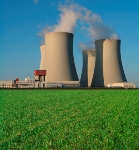
Japan Worst-case Scenario Unlikely to Cause Catastrophic Radiation Release (With Video)
While exposed spent fuel rods at the failing nuclear reactors in Japan pose new threats, the worst-case scenario would still be unlikely to expose the public to catastrophic amounts of radiation, says a University of Michigan nuclear engineering professor who is an expert on this particular kind of reactor.
"For the public, I don't believe it would be much higher than two additional chest x-rays," said John Lee, a professor in the Department of Nuclear Engineering and Radiological Sciences, citing the results of the Three Mile Island accident.
While the event appears to have progressed beyond Three Mile Island, Lee said that during that 1979 incident in Harrisburg, Penn., two chest X-rays were the worst radiation exposure experienced by plant workers. The public was exposed to much less.
Lee worked at General Electric during the time the company was making the type of boiling water reactor at the Fukushima plant. His book, "Risk and Safety Analysis of Nuclear Systems," will be published in May.
Spent fuel, which is fuel that has already been used but still retains a level of radioactivity, is a new concern, says Thomas Downar, a professor in the Department of Nuclear Engineering and Radiological Sciences.
"The worst thing that could happen now is the fuel rods could be exposed to the air and that could be, then, down to our last barrier," Downar said. "We could not have a recriticality, or a nuclear explosion. It's physically impossible in this kind of system."
Lee and Downar are among the professors in the No. 1-ranked University of Michigan Department of Nuclear Engineering and Radiological Sciences who are studying the technical issues involved in the emergency situation in Japan.
While the researchers understand that the situation is serious, they stress that a "meltdown" does not necessarily mean a major release of harmful radiation, and that the situation, while dire, is still more a kin to Three Mile Island than Chernobyl. A Chernobyl type of explosion is impossible in these plants, Lee said.
The new generation of nuclear reactors in the United States, the researchers say, are equipped with "passive" technologies that allow them to be cooled even during power blackouts. Water does not need to be pumped in, which has been a challenge in Japan.